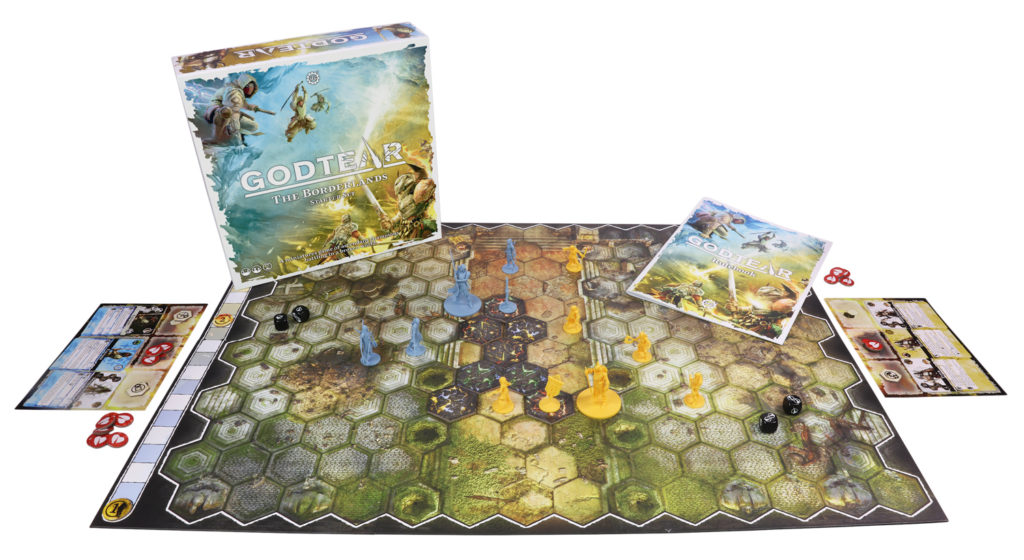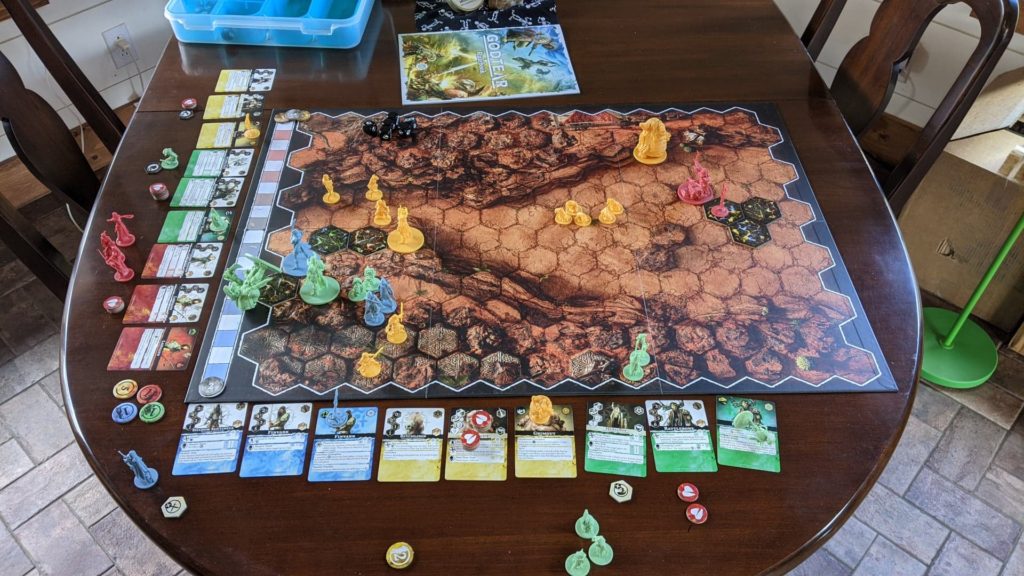Let me get this out of the way before delving into the topic at hand. The last time Steamforged Games made the news in this hobby, it was not their finest moment. The end of Guildball was notable for several reasons, not the least of which was the fact that Guildball was a generally excellent game, and it is always sad to lose one of those. That said, every game deserves a fair shot at winning players over, a Godtear has very much done that here.
Godtear is a fast-playing, highly competitive game that while technically a board-game, evokes most of the ethos of a tabletop war-game. In a modest hour to hour-and-half, you will certainly feel as if you have had a tactical, and skill-based skirmish.
Set in a world where the leavings of long-gone gods call to heroes of all kinds, Godtear is a low-model-count game that is as much about positioning finesse, as it is the thrill of combat. Players build a list out of 1-4 Champions (the game really sings at the recommended 3 Champion size, however), and collect them plus their associated Follower unit. Once deployed on the hex-board included in any of its starter boxes, the comparisons to MOBA/DotA/LoL PC games becomes clear. Gameplay is largely about claiming and scoring objective zones, and the visual of three vs three champions plus their assorted, and endless fodder, clearly channels the hit style of video-game.

Scoring in the game is unique, and quite thrilling. Each round the turn-counter straddles the center of a track. As players do certain things this counter is pushed and pulled, and whichever side it ends the turn in, that player claims its victory points. These points range from 1-3, with turn 3 being worth that massive three points. As the first player to 5VP wins, this makes the push-pull gameplay constantly tense, with every play having genuine implications for the outcome of the game.
The struggle over “steps” the game’s term for spaces on the scoring track, is deeply satisfying. They are earned by killing Followers, knocking down Champions, and both planting and defending banners on objective hexes. The game’s six scenarios are largely variations of the positions of these objective hexes, but also the conditions through which they might be created, moved, or removed altogether.
List building is one of the first moments where the nature of the game’s “simple, but infinitely deep” style comes through. Champions have no cost, and are seemingly balanced internally. This largely proved the case in a frankly huge volume of tests, where we made certain to field every currently available Champion at least twice. Each Champion, however, falls into one of four broad classes, with each scoring an extra “step” when they succeed in one of the game’s four ways of earning them. Not even taking into account individual skills/abilities/stats, the very first meaningful choice asked of players is which, and how many of each class to bring. Does one go for a balance or diverse approach, or are you self-aware enough to know you have a particular playstyle which encourages you to go all in with a particular class? Each class is then represented by several release Champions (with more on the way), meaning now you can try some wildly different units, even within a particular role.
Oh, and those wonderful oddballs. How about Grimgut (who definitely isn’t Grandpa Nurgle), with his surprising mobility tricks, and arsenal of puke/snot themed attacks and followers? Maybe Wraith’Marid, the teleporting assassin Lizardman is more your style? The game features a quirky list of characters who only sometimes play to their conventional tropes, but who all exude a shocking amount of personality for having only a few skills each. Lots of diversity in playstyle can be had already, and the design space has plenty of room for yet unexplored options.

Speaking of those skills, each Champion and Follower-Unit can only perform two actions per turn, with none repeated. From our experience you will generally wish you could do 2-3, which suggests lots of interesting choices are being made at all times. Gameplay primarily happens in two phases, a Plot Phase which tends to be about movement, buffing, debuffing, and zone control, and a Clash Phase which tends to be about combat. Exceptions exist, but the game makes its own interesting choice by having the Plot Phase be one player does all their actions, then the other, while the Clash Phase is alternating activations. The later is certainly more intense, though the game’s brisk pace means players will rarely check out.
As you can probably guess by now, the Fantasy Fisticuff’s team is really enamoured with this game. It is a mechanical joy to play, with incredibly rich tactics available despite there seemingly being so few options. You will be playing this game within thirty minutes of opening the box, and will be playing quickly within a couple of games. There is a lot of elegance on display, with everything from the rules to skills featuring very clear, very specific definitions, and clarity.
While the game’s merits are great, its value proposition is what I would call, merely fair. While a full three-Champion list is attainable, along with a Starter Box, for sub-$100, the spice for this game comes from owning and trying a range of Champions. At MSRP $30 USD for 2-7 pre-assembled board-game plastic models, with three cards, I will say Champions feel neither like a deal, nor particularly too expensive. The models themselves are pretty good, and are characterful, though perhaps not as surprisingly well done as A Song of Ice and Fire, another war-game-come-board-game with pre-assembled board-game plastic models.

The take-away I want to leave you with is weighted much, much more heavily towards the gameplay, versus the merely fair models. This game IS what Warhammer: Underworld wanted to be. It is skill-based and rewards time and effort, yet is also widely accessible, and easy to start.
I cannot give a game much higher praise than I am giving Godtear. We play a LOT of games to generate, and maintain this content for you amazing folks, and despite many of them being incredible, and linked to IPs we outright love, many evenings have been lost to theorizing top-tier(Tear?) plays, list combinations, or just playing one more game. If Warhammer Underworld, or even the competitive side of Warcry ever called to you, give this game a serious look. Perfect for kitchen tables, or game stores that can’t devote space to massive gaming tables, this game feels like a meaty wargame in a tight and tidy package.
And remember, Frontline Gaming sells gaming products at a discount, every day in their webcart!




Excellent review! Really well done, makes me want to play.
You should! Its affordable, competitive, and really satisfying!